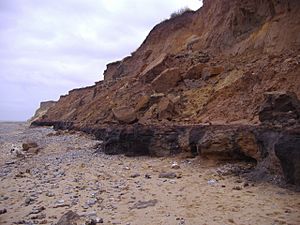Cromer Forest Bed facts for kids
Quick facts for kids Cromer Forest BedStratigraphic range: Pleistocene 2–0.5Ma |
|
|---|---|

The Cromer Forest Bed at the West Runton Cliffs
|
|
| Type | Geological formation |
| Unit of | Dunwich Group |
| Sub-units | Sheringham Member, Runton Member, West Runton Member, Bacton Member |
| Underlies | Middle Pleistocene glacial deposits |
| Overlies | Wroxham Crag Formation or unconformity with Chalk Group |
| Thickness | About 6 metres (20 ft) |
| Lithology | |
| Primary | Clay, Mud |
| Other | Sand |
| Location | |
| Region | |
| Country | |
| Type section | |
| Named for | Cromer |
| Named by | R.G. West |
| Location | The coast of North Norfolk from Weybourne to Happisburgh |
| Year defined | 1980 |
The Cromer Forest Bed is a special layer of earth found in Norfolk, England. It is made up of different types of soil, like clay, mud, and sand, that were laid down by ancient rivers and estuaries. This layer is very important for understanding the Pleistocene period, which was a time of ice ages. The Cromer Forest Bed itself formed between 2 million and 500,000 years ago.
It is about 6 meters (20 feet) thick. You can see it clearly in the cliffs near the town of West Runton. This area is famous for its many fossils, especially bones from ancient mammals. Even though parts of the bed are now hidden by coastal defenses, new fossils are still being found as the cliffs wear away.
Contents
What is the Cromer Forest Bed?
The Cromer Forest Bed is a geological formation. This means it is a specific layer of rock or sediment that scientists study. It tells us a lot about what England was like millions of years ago. The bed is named after the nearby town of Cromer. It helps scientists understand a specific time called the Cromerian Stage of the Pleistocene. This stage happened between 800,000 and 500,000 years ago.
Amazing Fossils Found Here
For over a hundred years, the Cromer Forest Bed has been a treasure chest of fossils. Scientists have found bones from many different kinds of animals. These include ancient deer, meat-eating animals, and birds.
The West Runton Mammoth
One of the most exciting finds was the West Runton Mammoth. This huge fossil skeleton was discovered in 1990. It is one of the most complete mammoth skeletons ever found in the UK. Finding such a large animal helps us imagine the ancient landscapes of Norfolk.
Ancient Humans in Norfolk
The Cromer Forest Bed is not just about animals. It also holds clues about early humans.
Oldest Human Footprints Outside Africa
Near the town of Happisburgh, scientists found the Happisburgh footprints. These are the oldest human footprints ever found outside of Africa! They are believed to be part of the Cromer Forest Bed layers. These footprints show that early humans were living in this area a very long time ago.
Tools and Animal Bones
Along with the footprints, other signs of ancient human life have been found. These include handaxes, which are stone tools used by early humans. Scientists also found bison bones with cut marks on them. These marks suggest that early humans used tools to butcher animals for food. These discoveries help us learn about how our ancestors lived and hunted.
See also
- Cromerian Stage
- Happisburgh
- Pakefield

